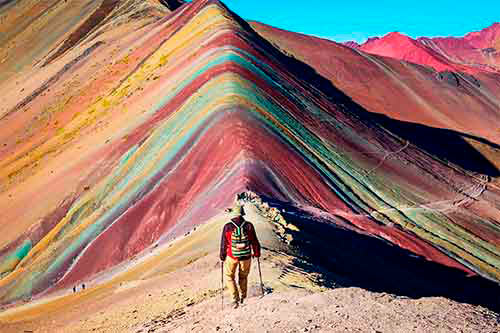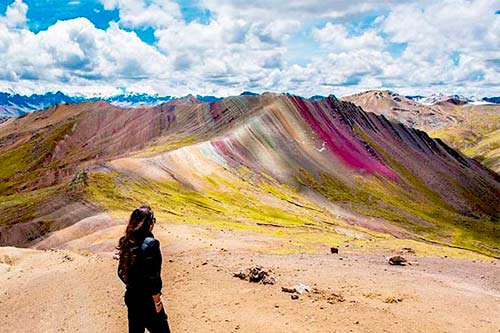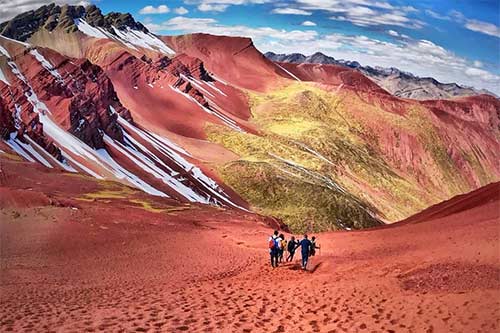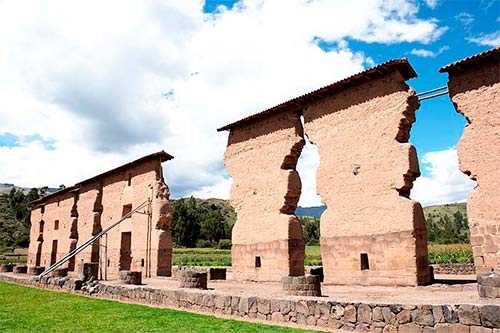The province of Canchis
Canchis is one of the thirteen provinces of Cusco. Its territory was inhabited by the Canchis culture, who allied themselves with the Incas in the fifteenth century. In this territory there are important archaeological remains. However, what stands out the most in this province is Vinicunca, the mountain of 7 colors. Many tourists visit this place, considered the second most popular in Cusco after Machu Picchu. Learn more about the province of Canchis, its location, climate and attractions.
All about province of Canchis
Explore the province of Canchis
Canchis is a Cusco province with a lot of history and natural landscapes to visit. There is the second most visited tourist attraction in all of Cusco: the amazing mountain of 7 colors. Learn more about this province!

1 Mountain 7 Colors
The mountain 7 colors was discovered in 2015. It is more than 100 kilometers from Cusco in Peru. Its mineral soil has colors similar to rainbows.

2 The mountain seven colors of Palccoyo
The mountain seven colors of Palccoyo is south of Cusco. The tour includes a 2 kilometer walk. Also a stone forest and adventurous option.

3 The red valley of Pitumarca
The red valley of Pitumarca is a new tourist attraction in Cusco. It is 5,000 meters high. It is famous for its red mountains of mineral spring.

4 Racchi archaeological site
Racchi was an Inca citadel south of Cusco. The temple of Wiracocha, the highest wall in the entire empire, is famous. The entrance costs 10 Peruvian soles.
The Andean valley of Canchis
Canchis is one of the thirteen provinces of Cusco, one of the most touristic. It is located south of Cusco. It is made up of eight districts which are: Sicuani, Checacupe, Combapata, Marangani, Pitumarca, San Pablo, San Pedro and Tinta. The city of Sicuani is the capital of the province.
The province is largely crossed by the Vilcanota River. There are many mountains that cross it. These are part of the so-called Cordillera del Vilcanota, at the top of which stands the snowy Ausangate (the highest in Cusco at 6,384 meters above sea level).
The province covers an area of 3,999 square kilometers. In its territory there are approximately 97 thousand inhabitants. It limits to the north with the province of Quispicanchi, to the east with the department of Puno, to the south with the province of Canas and to the west with the province of Acomayo.
The province was founded in 1833. In 1834, the city of Sicuani was designated as its capital. Its main tourist attractions are: the colonial bridge of Checacupe, the archaeological site of Raqchi, the red river, the mountain of Palcoyo, the red valley of Pitumarca and, of course, the mountain of the 7 colors (the Vinicunca).
Location
Sicuani, the capital of the province of Canchis, is located 137 kilometers by road from the city of Cusco. It is located south of the Cusco region, in the eastern part of the Andes Mountains. The province has an average altitude of 3,548 meters above sea level
How to get there?
To get to Sicuani (capital of the province) from the city of Cusco, you must take a public transport bus from Huayruropata street. The trip costs 15 Peruvian soles (approximately 5 US dollars).
Site Map
History of Canchis
The Canchis were an ethnic group made up of seven peoples who settled in the south of Cusco parallel to the Incas in the 14th and 15th centuries. They are credited with building important temples, citadels, and fortresses such as Waqrapukara.
During the wars between the Incas and the Chancas in the 15th century, the Incas requested the support of the Canchis. Thus an alliance was formed that would prosper during the conformation of the empire of the Incas. So the Canchis territory was part of the ‘Collasuyo’.
During the Spanish colony, the territory was part of important haciendas. After the independence of Peru in 1821, the territory was part of the Cusco province of Tinta. On October 14, 1833, under the government of Agustín Gamarra, Tinta was divided into two: the province of Canchis and the province of Canas. A year later, in 1834, the city of Sicuani was named the capital of Canchis.
At the beginning of the 21st century, the mountain of 7 colors, also called Vinicunca, was discovered in the foothills near the snowy Ausangate. Today this place is the main tourist attraction of Canchis.
Its tourist attractions
These are the main tourist attractions in the province of Canchis:
- The colonial bridge of Checacupe – Checacupe is one of the most important districts of Canchis. The town had an important Inca and colonial past. There it is still possible to see three bridges from different times: one Inca, one colonial and one modern. The town is located 98 kilometers by road from the city of Cusco.
- The archaeological site of Raqchi – This archaeological site is located 119 kilometers from the city of Cusco. It was an important Inca citadel and temple. It stands out for its construction called ‘The temple of Wiracocha’, which reaches 14 meters in height. It is the tallest discovered in the Inca period.
- The red river – The inhabitants call this place ‘Yawar mayu’ (a Quechua word that means ‘red river’). Its name is related to the color of the waters of this tributary of the great Vilcanota River. In the rainy season, the clay soil turns its waters red, creating an impressive landscape. It is located approximately 100 kilometers from Cusco.
- The mountain of Palcoyo – This mountain has a soil of various minerals that offer a splendid colorful landscape for visitors. Unlike Vinicunca, it does not require an arduous walk to get there. It is at 4,900 meters above sea level. The route to get there from Cusco is 100 kilometers on average. Despite its beauty, it still doesn’t receive many visitors.
- The red valley of Pitumarca – This valley of mountains has a clay soil that dyes it a shocking red. For visitors it is like being transported to Mars. The red valley is located just 7 kilometers from the town of Pitumarca. To get there you must make a final walk that takes 2 to 3 hours on average.
- The mountain of 7 colors – Vinicunca is one of the best tourist attractions in Cusco and Peru. It has a soil full of minerals that give it a rainbow appearance. To get there you must take a 5-kilometer walk. The walk is a challenge since it crosses geographies of more than 5 thousand meters of height. It is one of the most photographed places on the trip to Peru.
Weather
The climate in the province of Canchis varies according to each district. However, in most towns there is a cold temperate climate that varies from 22ºC. maximum up to 0ºC. at least.
The rains can occur on any day of the year. However, they are more frequent from November to April. The dry season occurs from May to October. In June, July and August the coldest temperatures of the year are presented.
Photo gallery
More information
The province of Canchis is famous for the beautiful Andean landscapes it offers. There are dozens of lagoons of great beauty. Highlights: the blue lagoon, the Mejía lagoon, the Llanganuco lagoon, the Choclococha lagoon and more.
A large part of the population of Canchis still speaks Quechua, the language they inherited from their Inca ancestors. Its squares still show colonial Catholic temples. Many of its customs and cultural aspects come from the same Inca era and have important influences from Spanish colonialism.
The characteristic flora and fauna of Canchis is the one that gets used to the Andean mountains. Highlights include icchu (wild mountain straw), llamas, alpacas, vizcachas and even the famous Andean condor.